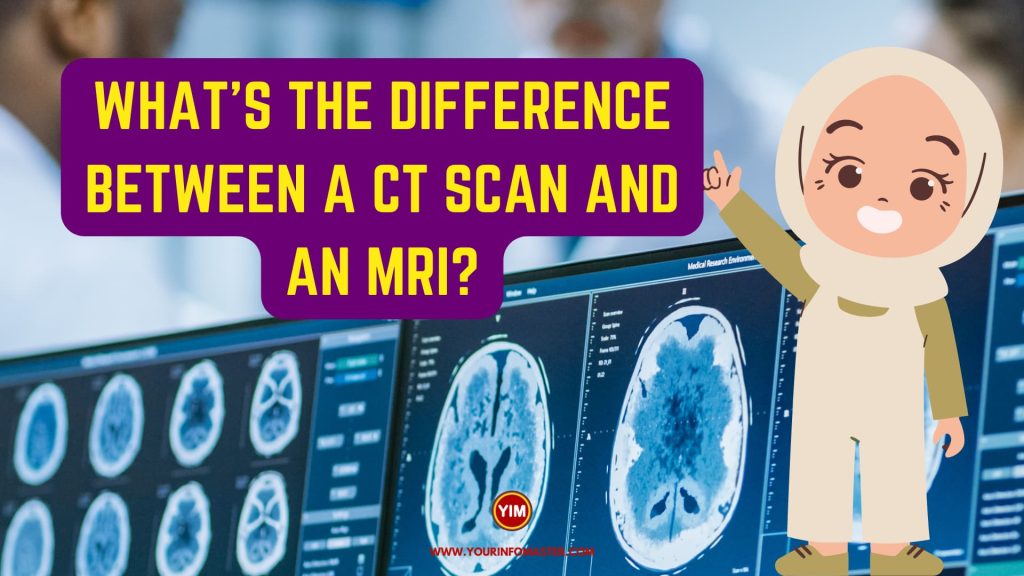I am going to explain the blog post “What’s the difference between a CT Scan and an MRI?“
When it comes to medical imaging, there are a variety of options available, including CT scans and MRIs. These two diagnostic tools are often used to diagnose various conditions and injuries, but what exactly is the difference between them?
In this blog post, we’ll explore the key differences between CT scans and MRIs in-depth, so you can have a better understanding of what each test involves and which one might be right for you. So, let’s dive in and take a closer look at the differences between CT scans and MRIs.
Check also: What is the difference between food chain and food web?
5 Differences Between a CT Scan and an MRI
Here is a list of 5 differences between a CT Scan and an MRI:
- Technology: CT scans use X-rays, while MRIs use magnets and radio waves.
- Radiation Exposure: CT scans expose patients to radiation, while MRIs do not.
- Cost: CT scans are generally less expensive than MRIs.
- Speed: CT scans are faster than MRIs.
- Image Clarity: MRIs provide clearer images than CT scans.
Check also: What is the difference between laminate and vinyl flooring?
Detail of 5 Differences between a CT Scan and an MRI
Technology
The technology used in CT scans and MRIs is quite different. CT scans use X-rays to generate images of the inside of the body. During a CT scan, the patient lies on a table that moves through a large, circular machine. The X-rays are directed at the patient from different angles, and the machine creates detailed images of the body by detecting how the X-rays pass through different tissues.
MRIs, on the other hand, use powerful magnets and radio waves to generate images of the body. During an MRI, the patient lies on a table that slides into a long, narrow tube. The machine creates a powerful magnetic field that causes the atoms in the patient’s body to align in a specific way. Radio waves are then directed at the patient, causing the atoms to emit signals that can be detected by the machine. These signals are used to create detailed images of the patient’s organs, bones, and tissues.
Radiation Exposure
One of the biggest differences between CT scans and MRIs is the amount of radiation exposure involved. CT scans use X-rays, which are a type of ionizing radiation. While the amount of radiation exposure from a single CT scan is relatively small, repeated exposure to ionizing radiation over time can increase the risk of cancer. In contrast, MRIs do not use radiation, making them a safer option for patients who need frequent or repeated imaging.
Cost
The cost of medical imaging can vary widely depending on the type of test and the location where it is performed. Generally speaking, CT scans are less expensive than MRIs. This makes them a more affordable option for patients who need frequent imaging or who may not have insurance coverage for their tests.
Speed
Another key difference between CT scans and MRIs is the speed at which the tests can be performed. CT scans are much faster than MRIs, usually taking only a few minutes to complete. This can be a major advantage for patients who are uncomfortable lying still for long periods of time or who may be claustrophobic. MRIs, on the other hand, can take anywhere from 30 minutes to an hour or more to complete. This longer scan time can be challenging for some patients, especially those who have difficulty remaining still for extended periods.
Image Clarity
The final major difference between CT scans and MRIs is the level of image clarity that each test can provide. MRIs are known for producing very clear, detailed images of the body, making them a better choice for certain types of injuries or conditions, such as brain or spinal cord injuries. CT scans can also produce detailed images, but they may not be as clear as MRI images in some cases. CT scans are generally better at visualizing bones and other hard tissues, while MRIs are better at visualizing soft tissues like muscles and organs.
Check also: What is the difference between carbon monoxide and carbon dioxide?
Conclusion
In conclusion, CT scans and MRIs are both valuable diagnostic tools that can help doctors diagnose a wide range of medical conditions and injuries. While they both have their advantages and disadvantages, the choice between a CT scan and an MRI ultimately depends on the individual patient’s needs and the specific medical question that needs to be answered.
Patients should talk to their doctors about their medical imaging options to determine which test is the best choice for their specific situation. With the right imaging test and a proper diagnosis, patients can receive the treatment they need to improve their health and well-being.
See also: What is the difference between dry needling and acupuncture?
If you really enjoyed the article “What’s the difference between a CT Scan and an MRI?,” then I would be very grateful if you’d help it spread by emailing it to your friends or sharing it on Twitter, Instagram, or Facebook. Thank you!
Have you read “What’s the difference between a CT Scan and an MRI?“ Which of these blogs are you reading, and how is it similar to one of them?

